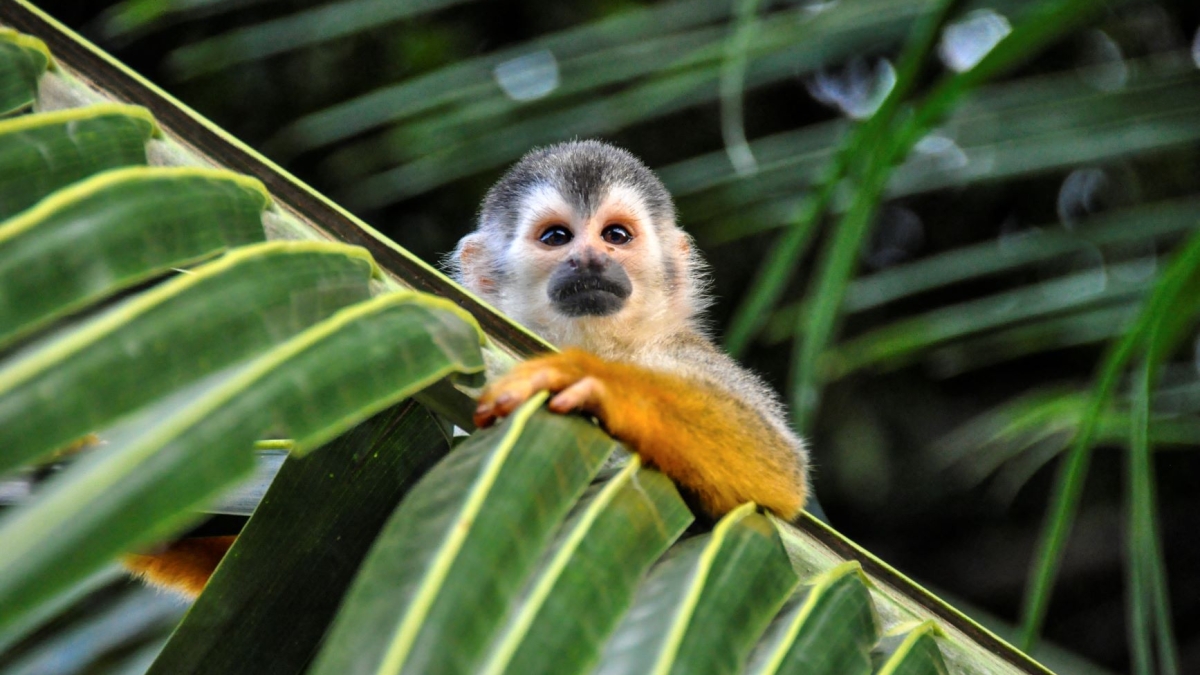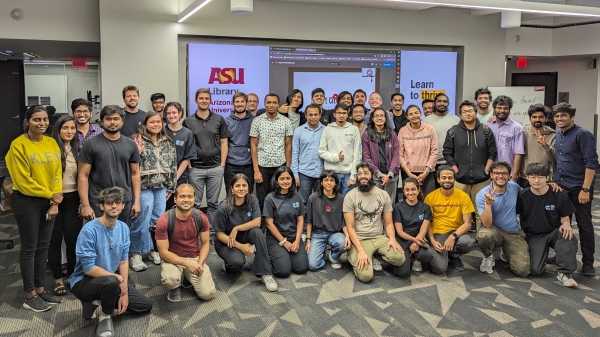To prevent another pandemic, police the wildlife trade, says ASU expert
Conservation scientist Leah Gerber proposes that a global body is needed to stop disease migrations from wildlife

COVID-19 may have jumped from a wild animal market in Wuhan, China, to people. If so, it’s not the first deadly disease to spring from nature.
Middle East respiratory syndrome is said to have a source at a camel market in Saudi Arabia. In the United States, the H1N1 swine flu originated in factory farms where animals are held in extreme confinement. And Ebola likely had its start in a chimpanzee habitat in West Africa.
A rising chorus is calling for wildlife markets to be shut down across the globe. Dr. Anthony Fauci, director of the National Institute of Allergy and Infectious Diseases and a member of the White House coronavirus task force, said, “It just boggles my mind that how when we have so many diseases that emanate out of that unusual human-animal interface that we don’t just shut (wildlife markets) down. … I would like to see the rest of the world really lean with a lot of pressure on those countries that have that, because what we’re going through right now is a direct result of that.”
Famed primatologist Jane Goodall echoed the same concern, calling for a global ban on all trafficking of wildlife.
“As we destroy the environment, animals are living in smaller and smaller spaces, and viruses are transferring from one animal to another,” Goodall said. “Then there’s wildlife trafficking and the handling of wild animals. They are kept crowded together with people in the meat markets. … This is where a virus gets the opportunity to jump from animals into people, and that’s what happened with COVID-19. … The awful thing is that this has been predicted. People knew it was coming; they talked about it, but nobody did anything.”
Recently Leah Gerber, a professor of conservation science and the founding director of the Center for Biodiversity Outcomes at Arizona State University, published an op-ed in Issues in Science and Technology calling for the creation of a global body to monitor and enforce a ban on wildlife trafficking. Without a ban and enforcement, global pandemics like the one the world is undergoing now will become a permanent fact of life, she says.
ASU Now talked to Gerber about what such an agency would look like and how it would operate.
Question: What creates the conditions for diseases to jump from the wild to human populations?
Answer: Environmental degradation, and especially habitat destruction, is the underlying problem that creates conditions favorable to zoonotic jumping. Wildlife trade is one symptom of this environmental degradation.
As humans continue to alter landscapes and destroy animal habitat, the remaining fragments become islands of rapid diversification of disease-causing microbes and their wildlife hosts. It’s the same phenomenon that Charles Darwin observed in the specially adapted finches on the isolated Galapagos Islands. Today, though, the increasing diversity of disease-causing microbes, combined with the wildlife trade, means a higher chance that any one of these microbes may spill over into human populations. As we deplete our forests, pollute our water and air and hunt or capture wildlife for markets, we are disrupting ecosystems and displacing viruses from their natural hosts. When this happens, they find a new host. Increasingly, that’s us.
Q: What should be done about the problem?
A: Although curtailing wildlife trade — both in local animal markets such as Wuhan’s and in the international trade in exotic species — would provide a significant near-term reduction of global risk from new infectious diseases, implementing that goal will require more than a simple ban. The long-term solution to stopping zoonotic leaps of disease will have to lie with protecting and restoring wildlife habitat and conserving biodiversity — a much more intractable problem that must be addressed as part of a transition toward sustainability. In addition, although we know that investing in biodiversity conservation is critical to reducing biodiversity loss, we also need a tested model to bring data to decisions regarding mitigating the risk of pandemics due to environmental degradation.
We need a global body with scientific heft and enforcement teeth both to spotlight drivers of the zoonotic leaps of disease and to lead a sustained fight against those drivers. This body should carry out the dual missions of reducing the global trade in wildlife and conserving the habitat and biodiversity that helps protect against zoonotic jumping.
Q: What would be the responsibilities of a body like that?
A: Such a body — let’s call it the Zoonotic Disease Commission, or ZDC — must immediately address three pressing tasks. First of all, support and speak for basic science. Dozens of studies have demonstrated the connections between environmental degradation, managing and mismanaging wildlife and the spread of novel infectious diseases. Yet management of natural resources across the globe rarely focuses explicitly on preventing infectious disease. ZDC will need to build an evidence base from these previous studies on disease outbreaks and make it widely available so nations, indigenous peoples, regional governments and other parties can make informed decisions about the potential disease consequences of natural resource interventions from protected areas on land to restored oyster reefs. This evidence base should include information on which interventions could be best tailored to contain which kinds of emerging infectious disease outbreaks.
Because newly emerging pathogen dynamics often do not conform to the simplified assumptions of classic epidemiology, we need a deliberate and strategic approach to synthesizing evidence — and filling in gaps — on the relationship between environmental degradation and risk of future pandemics. For instance, wildlife reserves and captive breeding programs could be among the most effective interventions against zoonotic jumps of infectious disease because they are aimed at maintaining healthy wildlife populations. But reserves that achieve high densities of threatened species may also increase our vulnerability to epidemics. Similarly, captive breeding programs may increase human contact with infectious disease due to higher population densities and cross-species contact. To minimize risks associated with pandemics, both reserves and captive breeding programs should occur in replicated localities within a species' native range.
Threats to biodiversity have five main causes: habitat loss, overhunting, pollution, introduced species and climate change. The science on how to best mitigate these threats has been siloed in the subculture of academic conservation science. ZDC must bring this science to the global agenda to ensure a sustainable future for biodiversity and help reverse the mounting threat of new pandemic diseases that result from zoonotic jumping.
Q: What kind of authority would that kind of a commission need?
A: A global governance regime with regulatory clout. The COVID-19 pandemic is giving the world a lesson on the risks associated with a globalized economy that continues to gobble up natural resources and habitat, and thus puts us all at increasing risk of exposure to novel pathogens. ZDC will help in identifying and policing the most threatening of those risks.
Many people argue for a permanent ban on wildlife trade as the only way to stop the next virus, yet experience with such bans is not encouraging. For example, bans on harvesting shark fins have had mixed success because they do not reduce demand for fins, and because they are difficult to enforce. Particularly in cultures that view wildlife as a natural resource to be exploited, or that depend on wildlife for livelihoods and sustenance, bans are unlikely to be effective.
Moreover, decades of research on and experience with nonbinding international agreements, such as the International Whaling Convention, demonstrate the weakness of such approaches, and the need for new models for global governance of common-pool resources. These lessons tell us that, to be effective, ZDC should have international convening power, regulatory power and mechanisms to assure national enforcement.
The conditions necessary for implementing such a model include political buy-in of nations and their domestic political constituencies, as well as international nongovernmental organizations and transnational civil society networks; a narrow focus on the specific problem of avoiding pandemics; a small number of lead participant nations, combined with a high degree of transparency to preserve legitimacy among all nations; and modest enforcement mechanisms, at least at first, to encourage buy-in at all governance levels.
Such conditions may seem daunting, but the COVID-19 pandemic provides the strongest possible collective motivation for achieving them. If we don’t institute ZDC, or something like it, we will simply be inviting another pandemic, and another and another. It’s only a matter of time. Only a supranational body with the power to identify, stop and punish the riskiest environmental and trade practices from the standpoint of pandemic can stand in the way.
Q: How would markets need to change?
A: Transform the global economy and markets to avoid these risks. We have sown what we are now reaping in COVID-19 through decades of unsustainable habitat destruction and resource extraction. People whose livelihoods are directly involved in the types of land use that often push exploited species to the brink of population collapse — thus amplifying the threat of zoonotic jumps — will need other viable options to ensure their well-being. Providing well-defined property rights for these local land users may be a necessary first step for seeking common interests with governments and, in some cases, the international community, in the pursuit of sustainable resource use.
Here, ZDC is necessary to support market-based approaches to sustainable production and consumption. For a market to function efficiently, it must be embedded within a governance context where property rights are enforced. And for a wildlife market to function sustainably, it must be governed by effective regulations, including harvest and use rights, permits or quotas associated with harvest, and rules regulating transfer of these harvest rights. Most existing wildlife markets are within a given nation, so rights are enforced through that nation’s court system with conservation goals monitored by state agencies and nonstate actors.
But many markets may not be meeting conservation goals because developing nations may be politically unable — or, in the case of China, unwilling — to enforce property rights and harvest restrictions. ZDC would help enact, support and enforce market-based mechanisms to incentivize sustainable production and consumption. Local and regional market-based solutions, such as sustainability certifications programs now operating for some fisheries and coffee-growing regions, offer models that could be applied to wildlife markets. Once such bottom-up approaches are in place, additional measures could include a permanent trade ban on high-risk species, with a long-term goal of eventually phasing out wildlife trade entirely.
Top image: Squirrel monkey hanging on palm leaf in Costa Rica. Photo by Getty Images/iStockphoto
More Science and technology

SpaceHACK highlights student solutions to environmental challenges, digital divide
By Adrianna Nine About 250 students from around the world convened online and at Arizona State University on March 22 for the ASU Interplanetary Initiative’s second annual SpaceHACK for…

New AI for a new era of discovery
As the legend goes, in 1665, Sir Isaac Newton sat in his garden at Woolsthorpe Manor in England and looked on as a lone apple dropped from a tree branch, falling straight down. This chance encounter…

ASU receives 3 awards for research critical to national security
Three researchers in the Ira A. Fulton Schools of Engineering at Arizona State University have received grant awards under the Defense Established Program to Stimulate Competitive Research, or…